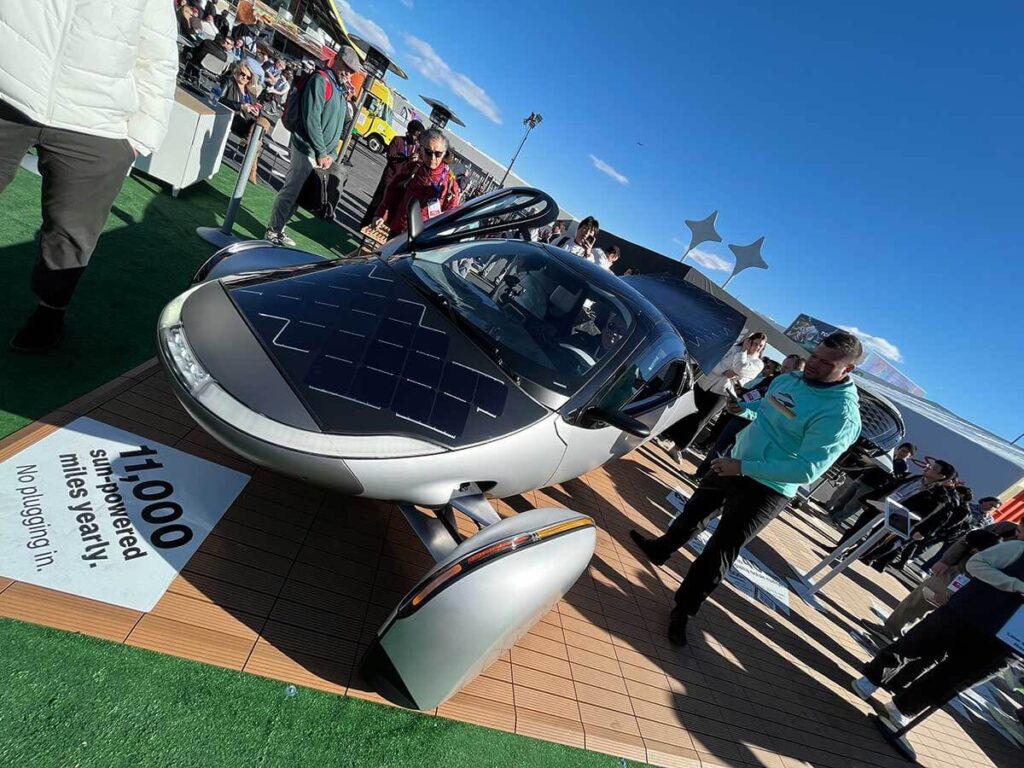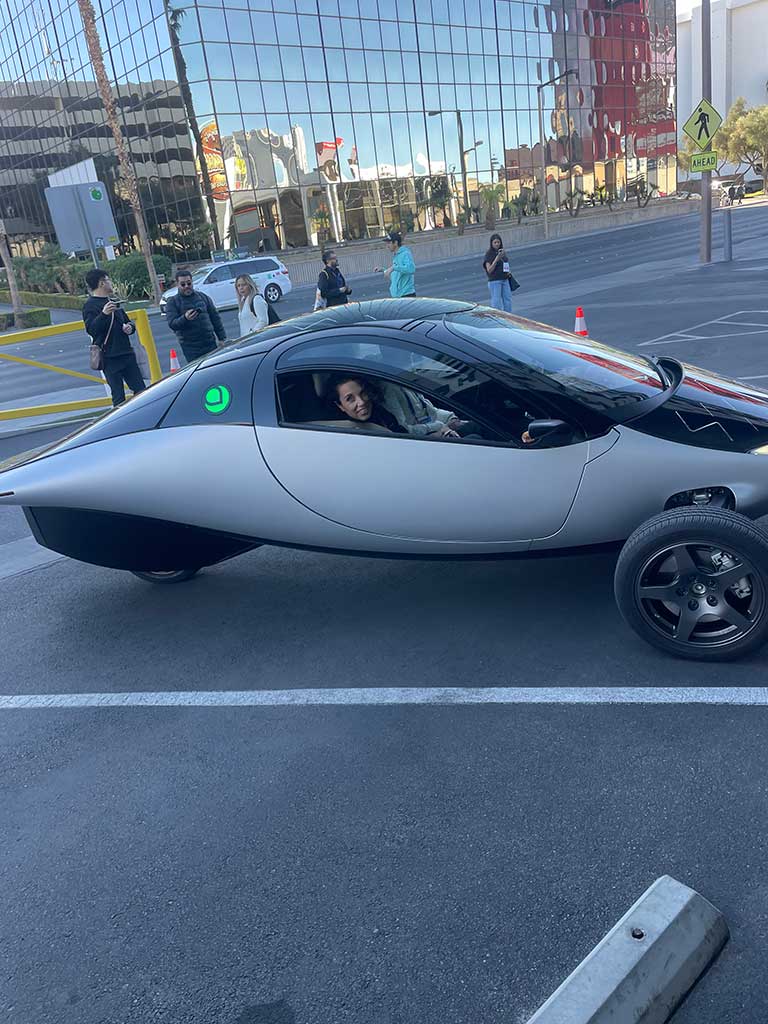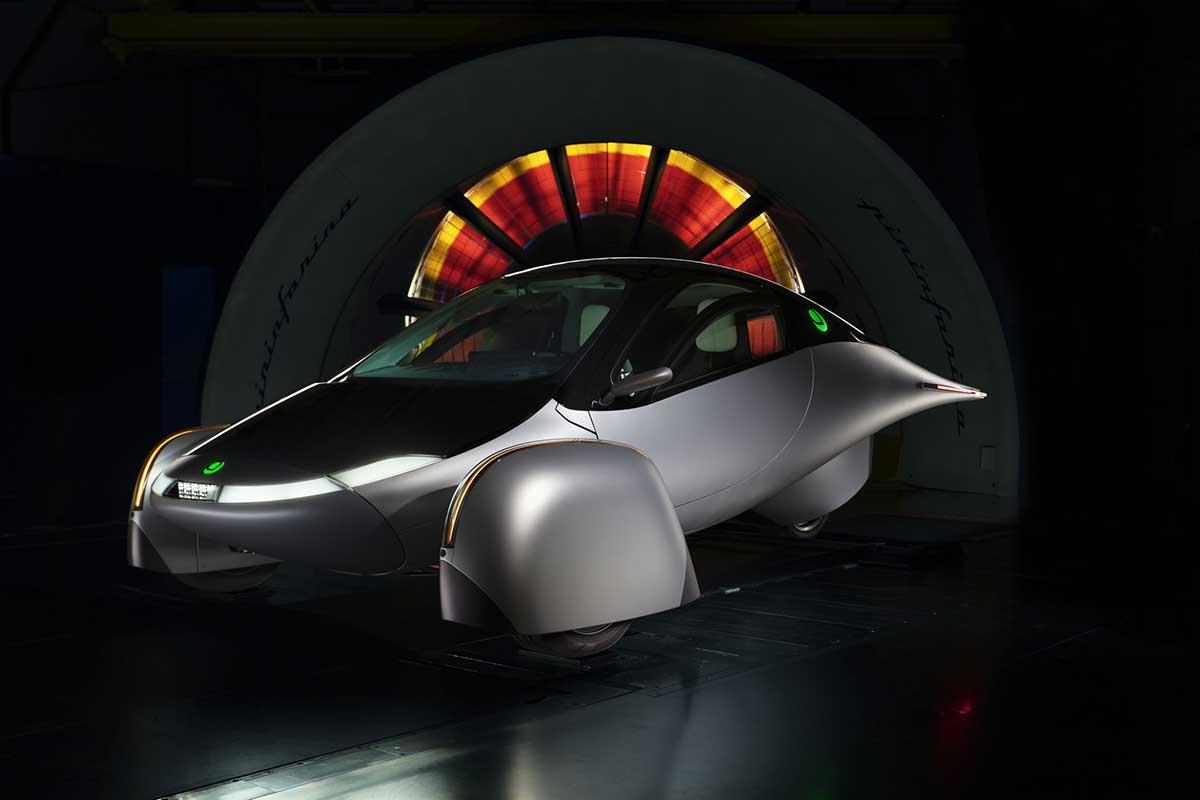In the overwhelming tech landscape of CES 2025, one vehicle innovation stood out as a beacon of sustainable transportation: the Aptera solar car. As I settled into the passenger seat for a test drive around the streets of Las Vegas with Chris McCammon, Aptera’s Head of Content, I couldn’t help but marvel at the sleek, futuristic design that promises to change the way we think about electric vehicles (EVs).
Harnessing the Power of the Sun
The Aptera solar car is not just another EV – it’s a mobile solar power plant on wheels. With about 700 watts of solar cells strategically placed on the roof, hood, dash and hatch, Aptera’s team designed the vehicle to maximize energy capture from the sun.
On a sunny summer day, the solar panels can generate up to 550 watts of power. According to McCammon, even in winter conditions, like those in Vegas during our test drive, the car still continued to produce a respectable 350 watts at peak power.
This solar prowess translates to real-world performance. In optimal conditions, drivers can expect to gain an average of 30 to 35 miles of range per day from solar power alone during the summer months. For daily commuters, leveraging the power of the sun could potentially eliminate the need for charging stops.

Unparalleled Efficiency and Range
The Aptera’ truly shines when it comes to efficiency. McCammon explained that the vehicle targets an impressive 100 watt-hours per mile, or ten miles per kilowatt-hour. To put this into perspective, most Tesla models consume around 300 watt-hours per mile. Thus, Aptera’s EV is three times more efficient.
This efficiency contributes to the vehicle’s remarkable range. With a fully charged battery, the Aptera boasts a 400-mile range. This means you could potentially drive from Los Angeles to San Francisco without needing to stop for a charge. This same trip, without charging stops, would be challenging for many current EVs on the market.
Charging Made Simple
While the solar panels provide a constant trickle charge, the Aptera also leverages traditional EV charging methods. Aptera designs hid a charging port, compatible with Tesla chargers, (including Superchargers) beneath the license plate. This clever design allows Aptera owners to take advantage of the extensive Tesla charging network.
Add to this an impressive charging speed: from zero to full charge in under an hour. McCammon attributed this speedy charging time to its smaller battery pack, which presents at less than half the size of a traditional EV battery while providing the same range.

Interior Blends Comfort and Innovation
While the Aptera’s exterior turns heads with its futuristic design (and it literally did during the entire length of our drive), its equally impressive 2-seat interior seamlessly blends comfort with cutting-edge technology.
One of the most striking features is the absence of a traditional rear-view mirror. Instead, the Aptera employs a high-definition camera system that offers a wider field of view to enhance safety and eliminate blind spots. (By the way, this type of “mirror camera” was featured in several stand alone booths at CES – here it’s already integrated).
The cockpit (if you will) features a sleek, minimalist design with an intuitive interface that puts all essential controls at the driver’s fingertips. For example the head’s up display integrates directly into the dashboard behind the steering wheel. The display provides access to the vehicle’s advanced features and real-time information about solar power generation and energy consumption. The panoramic windshield not only enhances visibility but also creates an open, airy feel inside the vehicle. This improves both the human-machine interface and driver experience.
Adding to the futuristic feel are the doors, which open upwards similar to the Delorean in Back to the Future. This not only adds a touch of drama but also makes entry and exit easier in tight parking spaces.
Aptera’s commitment to sustainability extends to the interior, where eco-friendly materials are used throughout. The spacious cabin features ergonomically designed seats that provide purpose-built support for long journeys so that drivers and passengers can remain comfortable, even on extended trips.
This thoughtful interior design complements Aptera’s one-of-a-kind exterior to create a cohesive and forward-thinking vehicle that’s as comfortable as it is efficient. All of this perfectly aligns with the company’s mission to transform the world of transportation into a more creative and less destructive space.

A Unique Classification
To a lawyer like me, one of the most intriguing aspects of the Aptera is its legal classification. McCammon explained that despite its car-like appearance and features, it’s registered as a motorcycle or autocycle, depending on the state. This classification brings several advantages:
- No need for a motorcycle license
- No helmet requirement
- Access to carpool lanes in some states
- Lower registration and insurance costs
- Smaller license plate to maintain aerodynamics
Aptera has worked diligently with its legal team to ensure these benefits are available in all 50 states. The company aims to help make the transition to solar-powered transportation as smooth as possible for drivers across the country.
Customization and Colors
For those wondering about personalization options (after all, for my first car, I bought the color and the car came with it), Aptera offers three standard colors: black, white, and silver – poetically named Noir, Luna, and Sol.
However, the vehicle’s body is wrapped rather than painted. This allows for easy customization. This wrapping approach not only provides flexibility in design but also eliminates the need for a costly and environmentally damaging paint shop. It also contributes to the vehicle’s affordability (which runs at about $40K base).
Production and Availability
As we cruised through the streets around the Las Vegas Convention Center (LVCC) , McCammon shared some exciting news about Aptera’s production plans. The company is gearing up to deliver a few units by the end of 2025, with full-scale production ramping up in 2026.
The vehicle’s body, a marvel of model engineering, consists of only six parts made from forged carbon fiber. This innovative design not only makes the Aptera stronger than steel by weight but also allows for quicker assembly compared to traditional vehicles with hundreds of body parts.
Production will be a collaborative effort, with Italian partners providing expertise in chassis and body manufacturing. The final assembly will take place at Aptera’s 80,000-square-foot facility in San Diego, California, where the solar panels and battery packs will also be produced.

The Future of Transportation
As our test drive came to an end, I couldn’t help but get even more excited than usual about the future of transportation. The Aptera solar car represents a significant leap forward in sustainable mobility. It uses just 10% of the energy of a gas-powered sedan. This equates to about ten Apteras on the road for the same amount of energy consumption of one Toyota Corolla.
With the potential to drive up to 11,000 miles a year powered solely by the sun, the Aptera could absolutely change how we think about fueling our vehicles. Just imagine rarely needing to visit a charging station and instead relying on the sun and occasional overnight charging from a standard outlet to keep you moving…
A Bright Future for Solar Mobility
As I stepped out of the Aptera, I knew that I had just experienced a glimpse of the future. With nearly 50,000 pre-orders already in place, it appears that Aptera has made believers out of folks already for its solar vehicle revolution.
What’s perhaps more important is that the Aptera solar car is more than just a vehicle – it’s a testament to the great potential of sustainable transportation solutions that can be environmentally friendly, practical and, well, super fun!
Maybe, just maybe, in the future, solar-powered mobility will become the norm rather than the exception. In any event, today, the Aptera stands as a shining example of what’s possible when smart engineers decide to harness the power of the sun. The Aptera is not just a wild ride – it’s a journey towards a cleaner, more sustainable future for all of us!

